The Role of Abstraction: Construal Level Can Improve Adolescents’ Idea Selection in the Domain of Social Creativity
Abstract
1. Introduction
1.1. Domain Generality and Specificity of Creativity
1.2. The Dilemma of Creative Idea Selection Research
1.3. Construal Level and Creative Idea Selection
2. Preliminary Study
3. Study 1
3.1. Study 1 Method
3.1.1. Participants and Design
3.1.2. Apparatus and Stimuli
3.1.3. Procedure
3.2. Study 1 Results
3.3. Study 1 Discussion
3.3.1. The Effect of Trait-Level Construals on Creative Idea Selection
3.3.2. The Effect of Task Domain on Creative Idea Selection
3.3.3. The Effects of Trait-Level Construals and Task Domains on Creative Idea Selection
4. Study 2
4.1. Study 2 Method
4.1.1. Participants and Design
4.1.2. Apparatus and Stimuli
4.1.3. Procedure
4.2. Study 2 Results
4.3. Study 2 Discussion
4.3.1. The Effect of State-Level Construals on Creative Idea Selection
4.3.2. The Effect of Task Domain on Creative Idea Selection
4.3.3. The Effects of State-Level Construals and Task Domains on Creative Idea Selection
5. Conclusions and Implications
6. Limitations and Future Directions
Author Contributions
Funding
Institutional Review Board Statement
Informed Consent Statement
Data Availability Statement
Conflicts of Interest
References
- Acar, Selcuk, Emel Cevik, Emily Fesli, Rumeysa Nalan Bozkurt, and James C. Kaufman. 2024. Testing the Domain Specificity of Creativity with Kaufman Domains of Creativity Scale: A Meta-Analytic Confirmatory Factor Analysis. The Journal of Creative Behavior 58: 171–89. [Google Scholar] [CrossRef]
- Amabile, Teresa M. 1996. Creativity in Context: Update to “The Social Psychology of Creativity”. Boulder: Westview Press. [Google Scholar]
- Anderson, Neil, Kristina Potočnik, and Jing Zhou. 2014. Innovation and creativity in organizations: A state-of-the-science review, prospective commentary, and guiding framework. Journal of Management 40: 1297–333. [Google Scholar] [CrossRef]
- Ayas, M. Bahadir, and Ugur Sak. 2014. Objective measure of scientific creativity: Psychometric validity of the Creative Scientific Ability Test. Thinking Skills and Creativity 13: 195–205. [Google Scholar] [CrossRef]
- Baer, John, James C. Kaufman, and Claudia A. Gentile. 2004. Extension of the Consensual Assessment Technique to Nonparallel Creative Products. Creativity Research Journal 16: 113–17. [Google Scholar] [CrossRef]
- Baer, Markus. 2010. The strength-of-weak-ties perspective on creativity: A comprehensive examination and extension. Journal of Applied Psychology 95: 592–601. [Google Scholar] [CrossRef]
- Baer, Markus. 2012. Putting Creativity to Work: The Implementation of Creative Ideas in Organizations. Academy of Management Journal 55: 1102–19. [Google Scholar] [CrossRef]
- Benedek, Mathias, Emanuel Jauk, Roger E. Beaty, Andreas Fink, Karl Koschutnig, and Aljoscha C. Neubauer. 2016. Brain mechanisms associated with internally directed attention and self-generated thought. Scientific Reports 6: 22959. [Google Scholar] [CrossRef]
- Blair, Cassie S., and Michael D. Mumford. 2007. Errors in idea evaluation: Preference for the unoriginal? The Journal of Creative Behavior 41: 197–222. [Google Scholar] [CrossRef]
- Carrera, Pilar, Dolores Muñoz, Itziar Fernández, and Amparo Caballero. 2018. Abstractness and Messages Describing Consequences Promote Healthier Behavioral Intentions. The Journal of Psychology 152: 515–27. [Google Scholar] [CrossRef]
- Diedrich, Jennifer, Mathias Benedek, Emanuel Jauk, and Aljoscha C. Neubauer. 2015. Are creative ideas novel and useful? Psychology of Aesthetics, Creativity, and the Arts 9: 35–40. [Google Scholar] [CrossRef]
- Dostál, Daniel, Alena Plháková, and Tereza Záškodná. 2015. Domain-Specific Creativity in Relation to the Level of Empathy and Systemizing. The Journal of Creative Behavior 51: 225–39. [Google Scholar] [CrossRef]
- Eling, Katrin, Fred Langerak, and Abbie Griffin. 2015. The Performance Effects of Combining Rationality and Intuition in Making Early New Product Idea Evaluation Decisions. Creativity and Innovation Management 24: 464–77. [Google Scholar] [CrossRef]
- Faure, Corinne. 2004. Beyond Brainstorming: Effects of Different Group Procedures on Selection of Ideas and Satisfaction with the Process. The Journal of Creative Behavior 38: 13–34. [Google Scholar] [CrossRef]
- Förster, Jens, Nira Liberman, and Oren Shapira. 2009. Preparing for novel versus familiar events: Shifts in global and local processing. Journal of Experimental Psychology: General 138: 383–99. [Google Scholar] [CrossRef]
- Förster, Jens, Ronald S. Friedman, and Nira Liberman. 2004. Temporal construal effects on abstract and concrete thinking: Consequences for insight and creative cognition. Journal of Personality and Social Psychology 87: 177–89. [Google Scholar] [CrossRef]
- Freitas, Antonio L., Peter Gollwitzer, and Yaacov Trope. 2004. The influence of abstract and concrete mindsets on anticipating and guiding others’ self-regulatory efforts. Journal of Experimental Social Psychology 40: 739–52. [Google Scholar] [CrossRef]
- Freitas, Antonio L., Peter Salovey, and Nira Liberman. 2001. Abstract and concrete self-evaluative goals. Journal of Personality and Social Psychology 80: 410. [Google Scholar] [CrossRef]
- Goldschmidt, Gabriela. 2016. Linkographic Evidence for Concurrent Divergent and Convergent Thinking in Creative Design. Creativity Research Journal 28: 115–22. [Google Scholar] [CrossRef]
- Griffioen, Anouk M., Michel J. J. Handgraaf, and Gerrit Antonides. 2019. Which construal level combinations generate the most effective interventions? A field experiment on energy conservation. PLoS ONE 14: e0209469. [Google Scholar] [CrossRef]
- Gu, Chuanhua, Jingjing Song, Enhe Hao, Zongkui Zhou, Chuang Gao, and Bi Ying Hu. 2018. Effects of real-world and virtual openness and Internet communication on social creativity: A serial mediation analysis. Social Behavior and Personality: An International Journal 46: 39–48. [Google Scholar] [CrossRef]
- Gu, Chuanhua, Xiaoqing Ma, Qianqian Li, and Chun Li. 2022. Can the Effect of Problem Solvers’ Characteristics on Adolescents’ Cooperative Problem Solving Ability Be Improved by Group Sizes? International Journal of Environmental Research and Public Health 19: 16575. [Google Scholar] [CrossRef] [PubMed]
- Gu, Chuanhua, Yali Wang, Caifu Wu, Xianglong Xie, Chengzhu Cui, Yaxian Wang, Wanzhen Wang, Biying Hu, and Zongkui Zhou. 2015. Brain Correlates underlying Social Creative Thinking: EEG Alpha Activity in Trait vs. State Creativity. Acta Psychologica Sinica 47: 765. [Google Scholar] [CrossRef]
- Gu, Chuanhua, Yan Liu, and Zongkui Zhou. 2010. The Internal Consistency and Domain-Specificity of Social Creativity Among Primary School Children. Psychological Science 33: 616–20. [Google Scholar]
- Guilford, Joy P. 1967. Creativity: Yesterday, today and tomorrow. The Journal of Creative Behavior 1: 3–14. [Google Scholar] [CrossRef]
- Han, DaHee, Adam Duhachek, and Nidhi Agrawal. 2014. Emotions shape decisions through construal level: The case of guilt and shame. Journal of Consumer Research 41: 1047–64. [Google Scholar] [CrossRef]
- Harrington, David M., and Christina S. Chin-Newman. 2017. Conscious Motivations of Adolescent Visual Artists and Creative Writers: Similarities and Differences. Creativity Research Journal 29: 442–51. [Google Scholar] [CrossRef]
- Hong, Eunsook, and Roberta M. Milgram. 2010. Creative Thinking Ability: Domain Generality and Specificity. Creativity Research Journal 22: 272–87. [Google Scholar] [CrossRef]
- Joshi, Priyanka D., and Cheryl J. Wakslak. 2014. Communicating with the crowd: Speakers use abstract messages when addressing larger audiences. Journal of Experimental Psychology: General 143: 351–62. [Google Scholar] [CrossRef]
- Julmi, Christian, and Ewald Scherm. 2015. The Domain-Specificity of Creativity: Insights from New Phenomenology. Creativity Research Journal 27: 151–59. [Google Scholar] [CrossRef]
- Kaufman, James C., and John Baer. 2004. The Amusement Park Theoretical (APT) Model of Creativity. International Journal of Creativity & Problem Solving 14: 15–25. [Google Scholar]
- Kaufman, James C., and John Baer, eds. 2005. Creativity Across Domains: Faces of the Muse. London: Psychology Press. [Google Scholar]
- Kim, Hakkyun, and Deborah Roedder John. 2008. Consumer response to brand extensions: Construal level as a moderator of the importance of perceived fit. Journal of Consumer Psychology 18: 116–26. [Google Scholar] [CrossRef]
- Li, Chun, Xiaolin Mu, Yuanyuan Tan, Chuanhua Gu, Bi Ying Hu, and Cuiying Fan. 2020. Do field-dependent individuals tend to have lower creativity than field-independent ones? The role of informational cues in electronic brainstorming. Interactive Learning Environments 31: 1106–25. [Google Scholar] [CrossRef]
- Liberman, Nira, and Jens Förster. 2009. Distancing from experienced self: How global-versus-local perception affects estimation of psychological distance. Journal of Personality and Social Psychology 97: 203–16. [Google Scholar] [CrossRef]
- Liberman, Nira, and Yaacov Trope. 1998. The role of feasibility and desirability considerations in near and distant future decisions: A test of temporal construal theory. Journal of Personality and Social Psychology 75: 5–18. [Google Scholar] [CrossRef]
- Licuanan, Brian F., Lesley R. Dailey, and Michael D. Mumford. 2007. Idea evaluation: Error in evaluating highly original ideas. The Journal of Creative Behavior 41: 1–27. [Google Scholar] [CrossRef]
- Luan, Mo, Shuang Wu, and Hong Li. 2020. The relationship between anticipated communication and creativity: Moderating role of construal level. Acta Psychologica Sinica 52: 11. [Google Scholar] [CrossRef]
- Lucas, Henry C., Jr., and Jie Mein Goh. 2009. Disruptive technology: How Kodak missed the digital photography revolution. The Journal of Strategic Information Systems 18: 46–55. [Google Scholar] [CrossRef]
- Manske, Mary E., and Gary A. Davis. 1968. Effects of simple instructional biases upon performance in the unusual uses test. The Journal of General Psychology 79: 25–33. [Google Scholar] [CrossRef]
- Mumford, M. D., K. E. Medeiros, and P. J. Partlow. 2012. Creative thinking: Processes, strategies, and knowledge. The Journal of Creative Behavior 46: 30–47. [Google Scholar] [CrossRef]
- Osborn, Alex F. 1957. Applied Imagination. New York: Scribner. [Google Scholar]
- Paulus, Paul B., Nicholas W. Kohn, Lauren E. Arditti, and Runa M. Korde. 2013. Understanding the group size effect in electronic brainstorming. Small Group Research 44: 332–52. [Google Scholar] [CrossRef]
- Pétervári, Judit, Magda Osman, and Joydeep Bhattacharya. 2016. The Role of Intuition in the Generation and Evaluation Stages of Creativity. Frontiers in Psychology 7: 1420. [Google Scholar] [CrossRef] [PubMed]
- Putman, Vicky L., and Paul B. Paulus. 2009. Brainstorming, brainstorming rules and decision making. The Journal of Creative Behavior 43: 29–40. [Google Scholar] [CrossRef]
- Rietzschel, Eric F., Bernard A. Nijstad, and Wolfgang Stroebe. 2010. The selection of creative ideas after individual idea generation: Choosing between creativity and impact. British Journal of Psychology 101: 47–68. [Google Scholar] [CrossRef]
- Rietzschel, Eric F., Bernard A. Nijstad, and Wolfgang Stroebe. 2014. Effects of Problem Scope and Creativity Instructions on Idea Generation and Selection. Creativity Research Journal 26: 185–91. [Google Scholar] [CrossRef]
- Rietzschel, Eric F., Bernard A. Nijstad, and Wolfgang Stroebe. 2019. Why great ideas are often overlooked: A review and theoretical analysis of research on idea evaluation and selection. In The Oxford Handbook of Group Creativity and Innovation. Edited by Paul B. Paulus and Bernard Arjan Nijstad. New York: Oxford University Press, pp. 179–97. [Google Scholar]
- Ritter, Simone M., Rick B. Van Baaren, and Ap Dijksterhuis. 2012. Creativity: The role of unconscious processes in idea generation and idea selection. Thinking Skills and Creativity 7: 21–27. [Google Scholar] [CrossRef]
- Siemon, Dominik, and Susanne Robra-Bissantz. 2018. A creativity support tool for cognitive idea stimulation in entrepreneurial activities. International Journal of Entrepreneurship and Small Business 33: 532–52. [Google Scholar] [CrossRef]
- Simonton, Dean Keith. 2003. Scientific creativity as constrained stochastic behavior: The integration of product, person, and process perspectives. Psychological Bulletin 129: 475–94. [Google Scholar] [CrossRef]
- Steele, Claude M. 1988. The Psychology of Self-Affirmation: Sustaining the Integrity of the Self. Advances in Experimental Social Psychology 21: 261–302. [Google Scholar]
- Stillman, Paul E., Zhong-Lin Lu, and Kentaro Fujita. 2020. Construal level shifts integration and segregation of the brain network. Journal of Experimental Psychology: General 149: 382–90. [Google Scholar] [CrossRef]
- Trope, Yaacov, and Nira Liberman. 2003. Temporal construal. Psychological Review 110: 403–21. [Google Scholar] [CrossRef]
- Trope, Yaacov, and Nira Liberman. 2010. Construal-level theory of psychological distance. Psychological Review 117: 440–63. [Google Scholar] [CrossRef] [PubMed]
- Trope, Yaacov, Nira Liberman, and Cheryl Wakslak. 2007. Construal Levels and Psychological Distance: Effects on Representation, Prediction, Evaluation, and Behavior. Journal of Consumer Psychology 17: 83–95. [Google Scholar] [CrossRef] [PubMed]
- Tsai, Claire I., and Ann L. McGill. 2011. No Pain, No Gain? How Fluency and Construal Level Affect Consumer Confidence. Journal of Consumer Research 37: 807–21. [Google Scholar] [CrossRef]
- Tu, Cuiping, and Fumin Fan. 2015. Domain Specificity of Creativity: Conception and Measurement. Advances in Psychology 5: 648–56. [Google Scholar] [CrossRef]
- Vallacher, Robin R., and Daniel M. Wegner. 1987. What do people think they’re doing? Action identification and human behavior. Psychological Review 94: 3. [Google Scholar] [CrossRef]
- Vallacher, Robin R., and Daniel M. Wegner. 1989. Levels of personal agency: Individual variation in action identification. Journal of Personality and Social Psychology 57: 660–71. [Google Scholar] [CrossRef]
- Van Bezouw, Maarten Johannes, Jojanneke van Der Toorn, and Julia Christina Becker. 2021. Social Creativity: Reviving a Social Identity Approach to Social Stability. European Journal of Social Psychology 51: 409–22. [Google Scholar] [CrossRef]
- Yagolkovskiy, Sergey R. 2016. Stimulation of individual creativity in electronic brainstorming: Cognitive and social aspects. Social Behavior and Personality: An International Journal 44: 761–66. [Google Scholar] [CrossRef]
- Zhang, Zhe, Xinmeng Wang, and Ruiqi Wu. 2021. Is the devil in the details? Construal-level effects on perceived usefulness of online reviews for experience services. Electronic Commerce Research and Applications 46: 101033. [Google Scholar] [CrossRef]
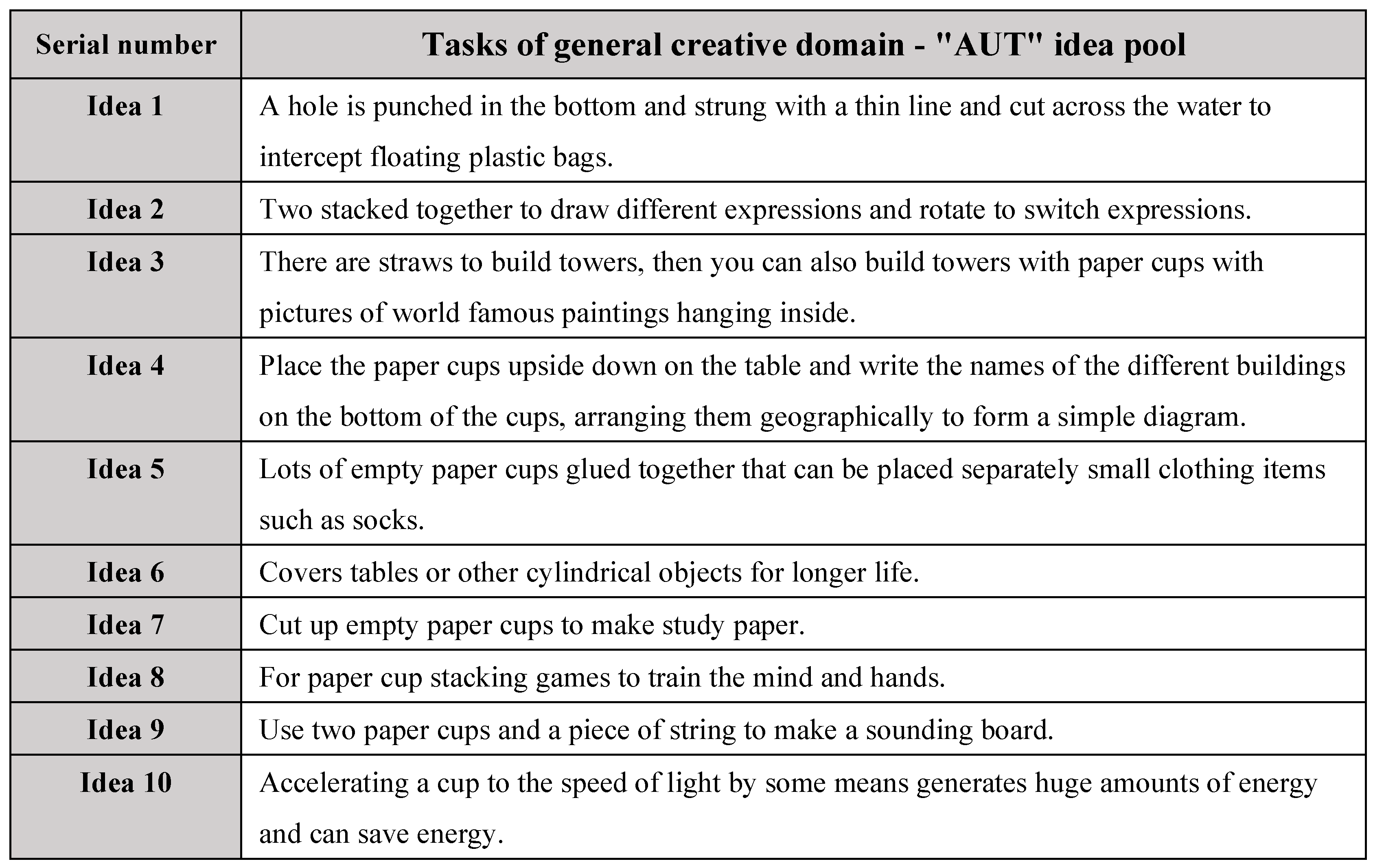
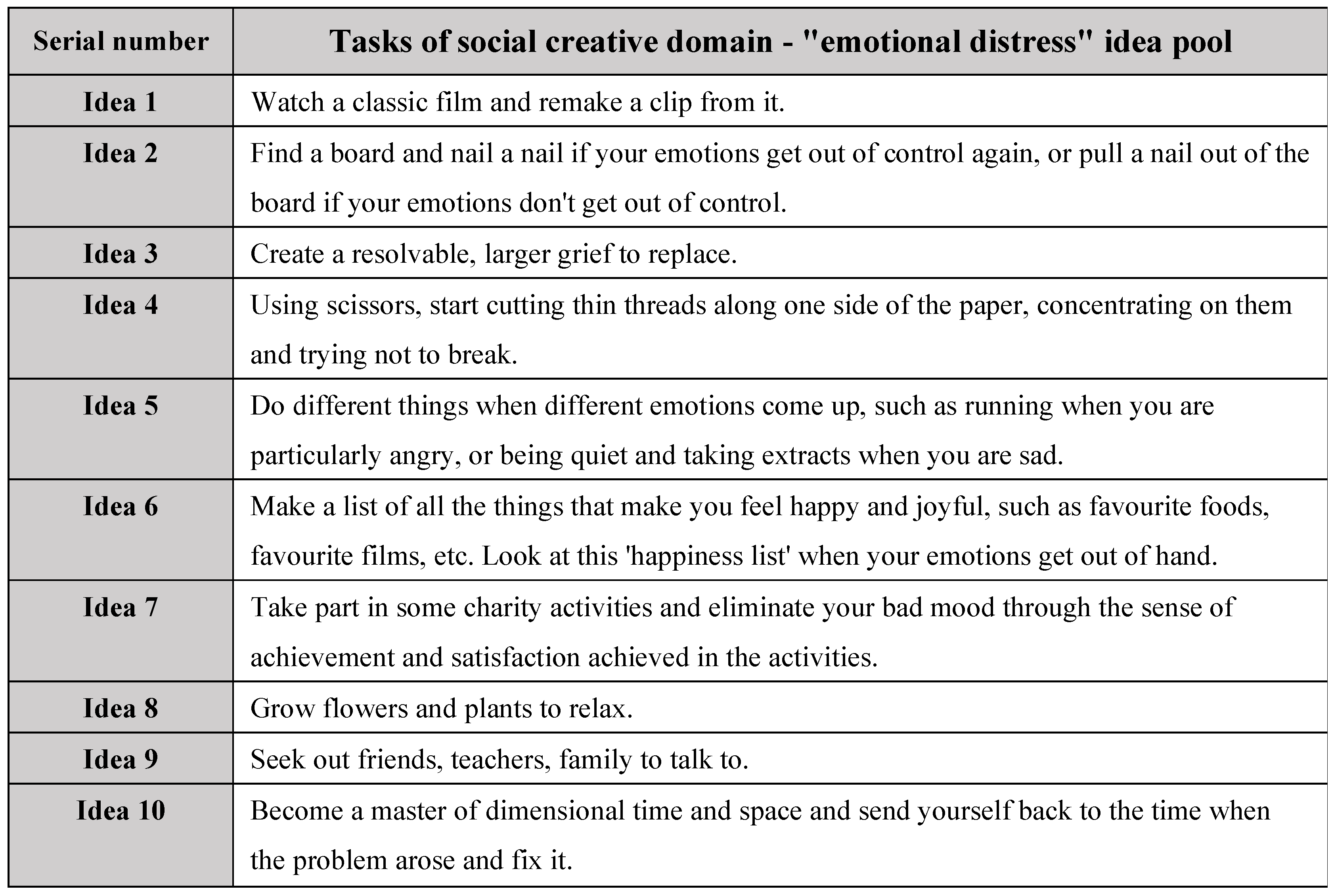
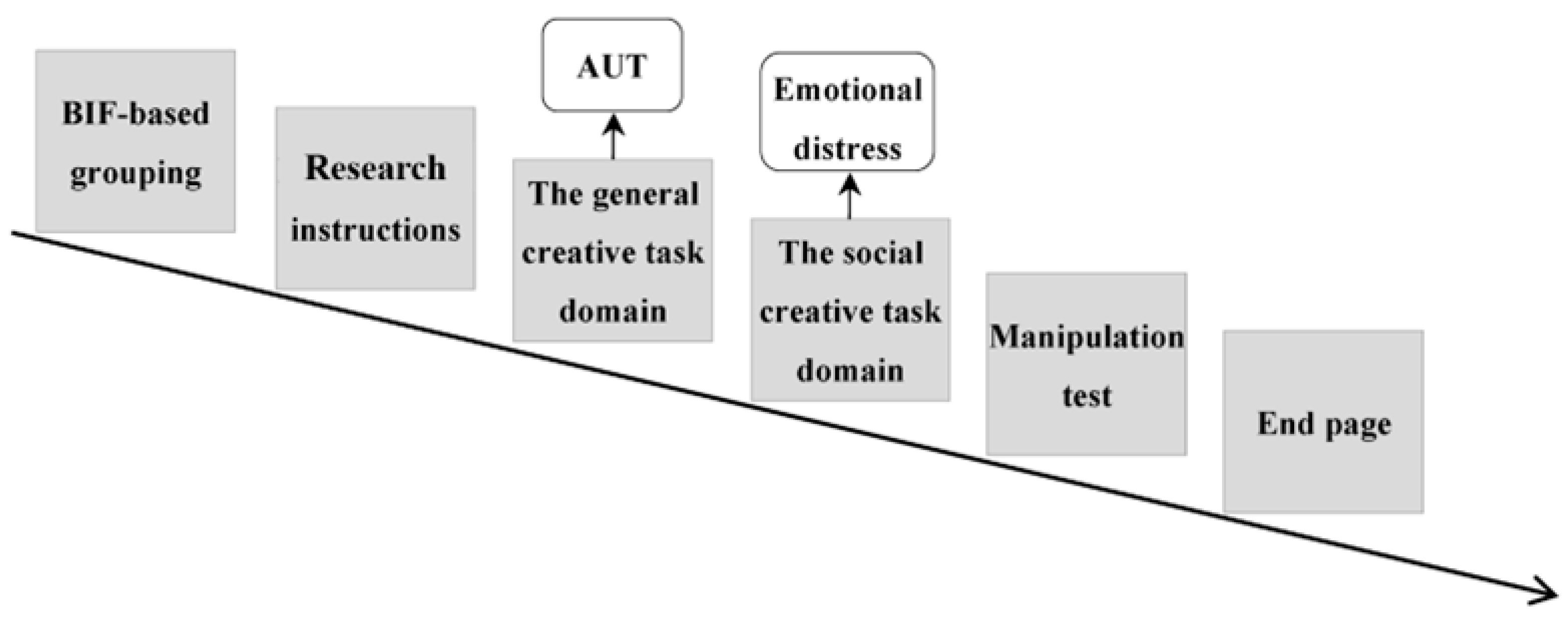

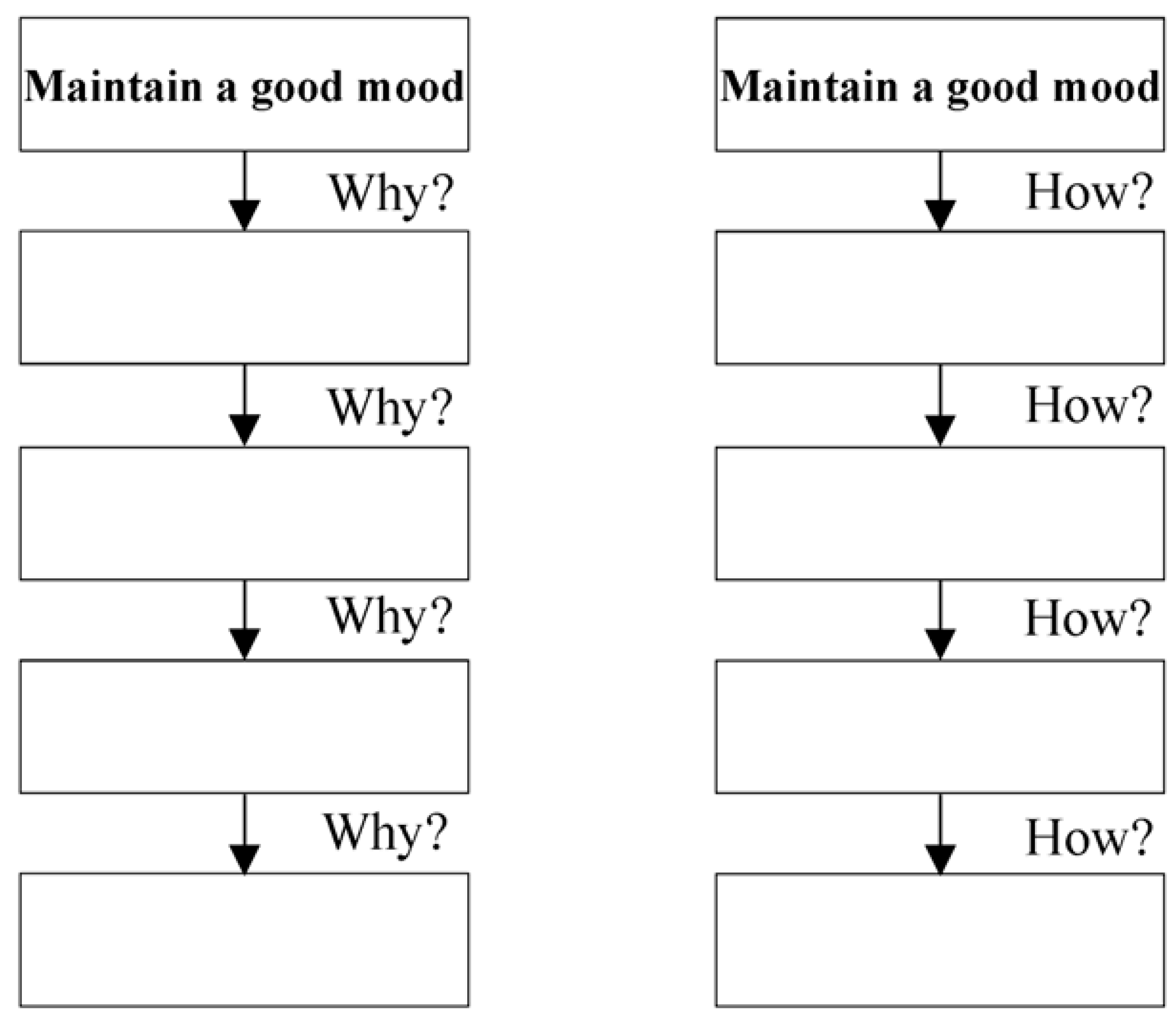
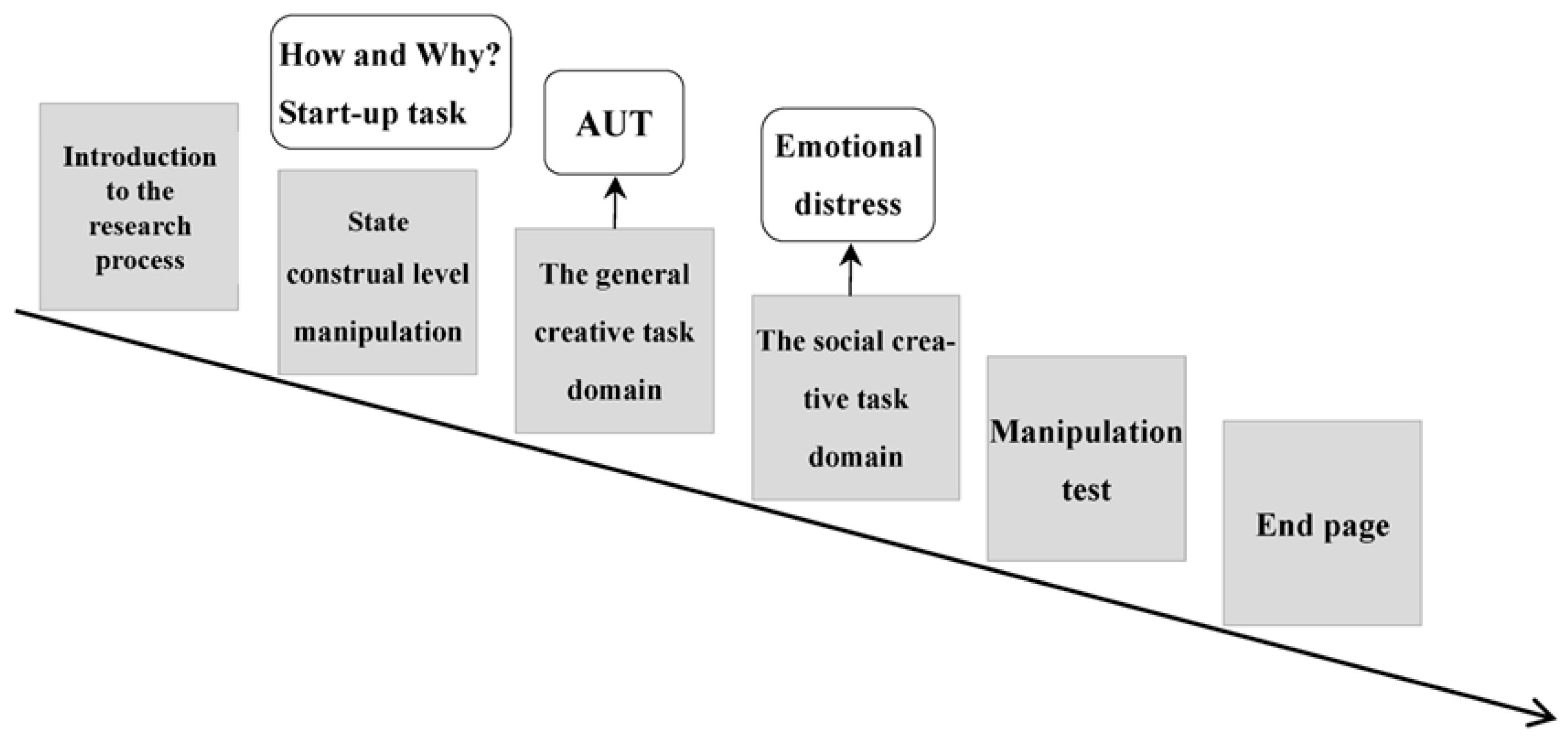
| BIF | Task Domain | Aspects of Creative Idea Selection | ||
|---|---|---|---|---|
| Creativity | Novelty | Applicability | ||
| High a | General | 3.60 (1.49) | 4.22 (1.04) | 4.34 (1.45) |
| Social | 3.00 (1.32) | 3.31 (1.29) | 4.32 (1.20) | |
| Low b | General | 2.89 (1.51) | 3.94 (1.18) | 3.85 (1.73) |
| Social | 2.77 (1.48) | 3.20 (1.48) | 4.29 (1.23) | |
| BIF | Task Domain | Aspects of Creative Idea Selection | ||
|---|---|---|---|---|
| Creativity | Novelty | Applicability | ||
| High a | General | 3.71 (1.43) | 4.14 (1.12) | 4.51 (1.25) |
| Social | 2.92 (1.33) | 3.11 (1.32) | 4.55 (0.95) | |
| Low b | General | 3.02 (1.55) | 3.95 (1.21) | 4.02 (1.70) |
| Social | 2.31 (1.19) | 3.13 (1.37) | 4.05 (1.65) | |
Disclaimer/Publisher’s Note: The statements, opinions and data contained in all publications are solely those of the individual author(s) and contributor(s) and not of MDPI and/or the editor(s). MDPI and/or the editor(s) disclaim responsibility for any injury to people or property resulting from any ideas, methods, instructions or products referred to in the content. |
© 2025 by the authors. Licensee MDPI, Basel, Switzerland. This article is an open access article distributed under the terms and conditions of the Creative Commons Attribution (CC BY) license (https://creativecommons.org/licenses/by/4.0/).
Share and Cite
Li, C.; Feng, S.; Zhang, Y.; Peng, H.; Ma, X. The Role of Abstraction: Construal Level Can Improve Adolescents’ Idea Selection in the Domain of Social Creativity. J. Intell. 2025, 13, 31. https://doi.org/10.3390/jintelligence13030031
Li C, Feng S, Zhang Y, Peng H, Ma X. The Role of Abstraction: Construal Level Can Improve Adolescents’ Idea Selection in the Domain of Social Creativity. Journal of Intelligence. 2025; 13(3):31. https://doi.org/10.3390/jintelligence13030031
Chicago/Turabian StyleLi, Chun, Shuo Feng, Yue Zhang, Hui Peng, and Xiaoqing Ma. 2025. "The Role of Abstraction: Construal Level Can Improve Adolescents’ Idea Selection in the Domain of Social Creativity" Journal of Intelligence 13, no. 3: 31. https://doi.org/10.3390/jintelligence13030031
APA StyleLi, C., Feng, S., Zhang, Y., Peng, H., & Ma, X. (2025). The Role of Abstraction: Construal Level Can Improve Adolescents’ Idea Selection in the Domain of Social Creativity. Journal of Intelligence, 13(3), 31. https://doi.org/10.3390/jintelligence13030031





